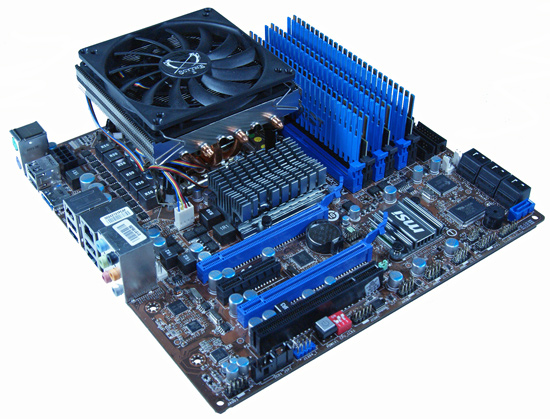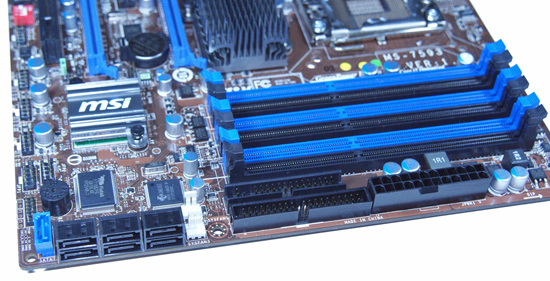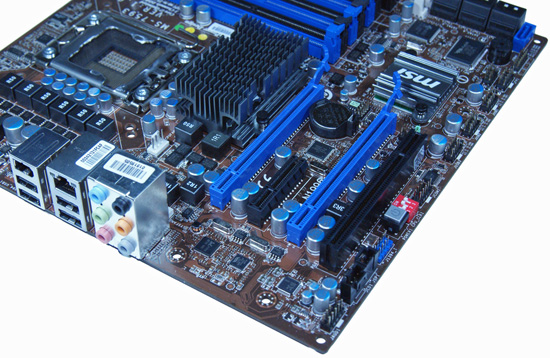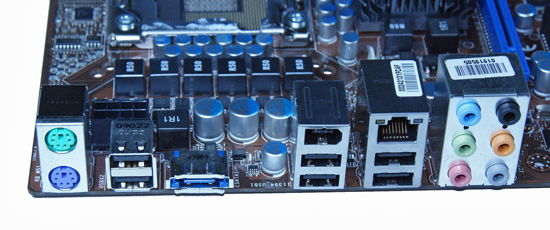Board Layout


Taking a quick tour around this board, we find the overall layout is very good. MSI placed the 24-pin and 8-pin ATX power connectors, floppy/IDE connectors, and the SATA ports near or along the edge of the motherboard. We would have preferred that MSI drop the floppy connector altogether and utilize the space for the two chassis headers. These two fan headers are extremely difficult to utilize with a double slot card like the GTX260 216 or HD 4890 inserted in the first PCIe x16 slot. The rear of the video card covers the fan headers and depending on the card, the first header might not be usable.
A couple of other items we would like to see changed is the color of the PCB and the removal of the Overclocking Block Switch next to the Power On button. Considering MSI’s latest blue on black color scheme for their performance oriented boards, the blue/black on a brown PCB just does not look right on this board. However, in order to meet cost targets this was one of the areas that had to suffer and in the end color really does not affect performance. As far as the overclocking block, we could not find a single opportunity where it provided an advantage over changing Bclk in the BIOS. We think the space could be better utilized for a reset button or clear CMOS button - or both to be honest.
Installation of our peripherals was easy and the board fit well in several case designs. One important item worth mentioning is that our larger air coolers like the Vigor Monsoon III LT fit fine on the board and did not block the first DIMM slot as it does on the ASUS Rampage II GENE board. The back of the board is clean and all of our various air coolers that require a back plate worked fine. Let’s take a quick look at the rest of the board.

The CPU socket area is open and unobstructed for the most part. The socket area is surrounded by the IOH heatsink, MOSFETs, and several capacitors, but we had no issue installing large air coolers or a couple of water blocks. This board features a 6-phase power design with three Low RDS(on) MOSFETs per channel along with the R50 ferrite core closed chokes. The MOSFETs are not passively cooled, though mounting holes are provided on the board if you happen to have a knack for making your own or have an old Eclipse board lying around. We highly suggest active cooling in this area if you are overclocking to ensure stability and longevity. The board features cooling mounting holes for both the LGA775 and LGA1366 heatsink designs. MSI also provides a six light LED setup below and to the left of the 8-pin ATX power connector that indicates the number of power phases in use.

The floppy drive connector, IDE connector, and 24-pin ATX power connector are located along the edge of the board behind the memory slots. Moving to our left, we have the two chassis fan headers that potentially can be blocked by most two slot video cards. Intel’s ICH10R provides support for the six black SATA ports and features RAID 0/1/5/10 capabilities with Intel’s excellent Matrix technology. JMicron’s JMB363 powers the blue SATA7 slot and the eSATA port on the I/O panel. The ICH10R is cooled by a low-rise aluminum heatsink . Along the left edge of the board is the front panel connector, USB 2.0 headers, and IEEE 1394a header.

The expansion slot layout is good considering the limited space. The PCIe x4 slot and PCI slot become physically unusable if dual-slot graphics cards are placed in the PCIe x16 slots. A low-rise aluminum heat sink covers the X58 chipset and provided decent but not spectacular cooling when overclocking. We noticed IOH temperatures hitting 86C when overclocking the board and providing 1.15~1.20V to the IOH to reach Bclk speeds above 220. During normal operation, the IOH temperature fluctuated between 46C~54C. This is another area that could use active cooling from your case fans or a small 40mm fan for heavy overclocking situations.

Last but certainly not least is the I/O panel. There are the standard issue PS/2 keyboard and mouse ports, Gigabit LAN port with LED activity lights, six USB 2.0 ports, one IEEE 1394a port, one eSATA port, and an audio panel.
















25 Comments
View All Comments
Gary Key - Monday, May 25, 2009 - link
I mentioned on page three about the IOH temperatures, up around 86C or so when overclocking and the board really needs some type of active cooling in that area for 24/7 OC settings. Those temps are still within spec but about 12C higher than the GENE board at like settings. That said, this heatsink worked better than the Platinum board from MSI.GeorgeH - Saturday, May 23, 2009 - link
Wow. With this board and one of Microcenter's $200 i7 920's, you could build yourself what is essentially a top of the line PC for next to nothing right now. It really makes me wonder what to expect from i5 - it's starting to look like it'll have to be either dirt cheap or offer >90% of i7's performance for it to be a truly interesting option.FaaR - Saturday, May 23, 2009 - link
As a happy owner of the ASUS Rampage II Gene, I really must say this looks like a great board. I know many people think the Gene's overpriced, and on some level I agree with them. I just happen to think the price I paid was worth it. ;)To those that don't like the high cost of the Gene, this board would make an excellent substitute. Heck, it's even a smidgen faster in most tests, how's that for value huh? :D Still, on the whole I prefer my Gene. It has the attention to detail where it really counts, IMO, apart from the MSI board having PCIe x4 instead of the Gene's x1 (slots which become blocked anyway as soon as a double-wide GPU is insterted in the nextdoor x16 slot, making the advantage rather moot...)
The Gene has passive cooling on the VRMs as standard, makes me breathe a bit easier with regards to the safety and longevity of the components involved. The Gene also has five WELL-PLACED fan headers (all of them of the 4-pin variety for PWM speed management). It has PCIe x16 slots with convenient little pedals to release the board in the slot, instead of those horrific pull-tabs on the MSI board which always makes me curse whenever I have to blindly dig around inside of a case to get the card out. I also really REALLY like the Gene's software X-Fi sound, the driver works great and sounds great once it's been set up.
And then there's the little power/reset/safe memory/cmos clear buttons too, for those who like stuff like that. Personally I can't really reach any of the mobo buttons once the board's mounted in my case even if the lower PCIe slot isn't housing a 2-slot GPU, but at least they're there for those who can, and they glow in soft-off mode to indicate the board has power so you don't go pulling stuff out without first shutting things off properly...
All in all, the ASUS board is a bit more polished, although at a greater cost. As is usually the case. :)
goinginstyle - Saturday, May 23, 2009 - link
Wow, somebody finally gets the fact that overclocking and Crysis is not what makes an article, although I like your overclocking results. I hope the roundup gives us more tests results like these. I thought this was a full review based on seven pages as you covered just about anything I wanted to know in this preview. Thank you for a preview that is just not pictures and press release text!danger22 - Monday, July 26, 2010 - link
does anyone know if win server 2008 x64 supports this board?